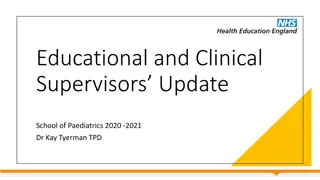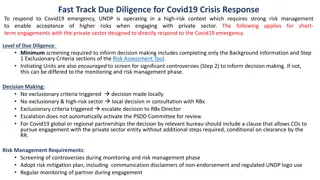
Understanding Local COVID-19 Epidemic Data Analysis
Learn how to analyze COVID-19 infection data by age groups from reliable sources. Follow step-by-step instructions to extract and analyze relevant data using spreadsheet software for statistical insights.
Download Presentation

Please find below an Image/Link to download the presentation.
The content on the website is provided AS IS for your information and personal use only. It may not be sold, licensed, or shared on other websites without obtaining consent from the author. If you encounter any issues during the download, it is possible that the publisher has removed the file from their server.
You are allowed to download the files provided on this website for personal or commercial use, subject to the condition that they are used lawfully. All files are the property of their respective owners.
The content on the website is provided AS IS for your information and personal use only. It may not be sold, licensed, or shared on other websites without obtaining consent from the author.
E N D
Presentation Transcript
Recognising the COVID-19 Pandemic from data Senior Secondary Mathematics (Compulsory Part): Uses of Statistics Curriculum Development Institute, Education Bureau 1
Recognising the local epidemic If we wish to have a deeper understanding of the local epidemic of COVID-19 and explore the infection of virus by age groups, how should we proceed? Before finding relevant data for analysis, students are reminded that Data should be sought from reliable sources (e.g. websites of relevant Government Departments) Analyse data with a careful and rigorous attitudeto avoid subjective and false conclusions 2
Recognising the local epidemic If we wish to have a deeper understanding of the local epidemic of COVID-19 and explore the infection of virus by age groups, how should we proceed? Reliable data source: For example, the data of government departments. The government's DATA.GOV.HK" webpage provides data on COVID-19 from the Department of Health (in addition to accurate and reliable data, the webpage provides CSV files, which can be operated with spreadsheet software) https://data.gov.hk/tc-data/dataset/hk-dh-chpsebcddr-novel-infectious-agent 3
Activity 1: Analysing the ages of confirmed patients using IT Firstly download the data "Details of suspected/confirmed 2019 coronavirus cases in Hong Kong" from the "Data in Coronavirus Disease (COVID-19)" of the website "DATA.GOV.HK". In this activity, students will use a spreadsheet to analyse the data and complete the following table. Confirmed cases Number Male Female All Range Mean Mode Median Upper quartile Lower quartile Age The following steps demonstrate how to analyse the data of Male s confirmed cases. 4
Step 1: Download the latest data from the "Data in Coronavirus Disease (COVID-19)" of the website "DATA.GOV.HK". Step 2: Select HOME Sort & Filter Filter HOME Sort & Filter Filter 5
Step 3: Click the arrow button next to Gender, choose M only and click confirm . Then, click the arrow button next to Confirmed/probable and choose Confirmed and click confirm . The results are the confirmed cases for male only. It shows at the bottom of the table that there are 599 records, i.e. the number of the confirmed cases for male is 599 (use data as at 16 June 2020). confirm 599 records 6
Step 4: Use the mouse to click the first record of Age (i.e. cell E2), then press the three buttons Shift , Ctrl and down arrow together to select all the records of age for all male confirmed cases. Then, press Ctrl and C to copy these records. Step 5: Click the plus sign next to worksheet 1 to create a new worksheet. 7
Step 6: Click cell A1 of worksheet 2 and press Ctrl and V to paste all records of male confirmed cases under Column A of worksheet 2 (as shown on the right). Then, we can use different functions to find the values on the table below. Confirmed cases Male Number 599 Range Average Mode Age Median Upper Quartile Lower Quartile 8
Step 7a: Input related information under Column C and enter different formulae in the relevant cells under Column D. As this activity involves a large number of data, it is suggested to use information technology to calculate the statistics. Students can then focus on analysing the results. 9
Step 7b: Input related information under Column C and enter different formulae in the relevant cells under Column D. 10
Step 7c: Input related information under Column C and enter different formulae in the relevant cells under Column D. 11
Activity 1: Analysing the ages of confirmed patients using IT a) Refer to the above steps, try to get the relevant values for female and all cases and complete the following table. Confirmed cases Number Male 599 93 37.1 20 35 51 22 Female All Range Mean Mode Median Upper quartile Lower quartile Age b) Represent the ages of male, female, and all patients by boxplots and compare their distributions. 12
Suggested answers as follows (using data as at 16 June 2020) Confirmed cases Male Female All Number 599 513 1112 Range 93 95 96 Mean* 37.1 38.2 37.6 Mode 20 20 20 Age Median 35 34 35 Upper quartile 51 52 52 Lower quartile 22 23 22 *correct to three significant figures 13
We can use the software GeoGebra and input the following command to draw the required boxplots. The command of BoxPlot is BoxPlot(50, 5, 0, 22, 35, 51, 93) , the meanings, in sequence, of these seven numbers are: the position of the boxplot, the width of the boxplot, minimum values, lower quartile, median, upper quartile and maximum value. Ages of male, female and all confirmed cases (as at 16 Jun 2020) By observing the boxplots, we find that the distributions of ages of male, female and all cases are very similar. 14
Activity 2: Comparing the cases in different age groups Observe and guess By observing the above table and boxplots, some students find that no matter whether it is male, female or all cases, 25% of the data are concentrated between the twenties and the thirties and the modal age of three groups are all 20. Do these results indicate that the age group of near 20 years old is more commonly infected with COVID-19 than other age groups? 15
Activity 2: Comparing the cases in different age groups Analysis To know whether the guess is correct, we may first notice that numbers of people in different age groups are different. So, we need that data in order to further analyse which age group of people is more commonly infected with COVID-19. Population of Hong Kong by age and sex, mid-2018 Sources: Census and Statistics Department: Living with Statistics https://www.censtatd.gov.hk/hkstat/sub/sc460.j sp?productCode=B8XX0025 16
Activity 2: Comparing the cases in different age groups a) Complete the following table by the data Details of suspected/confirmed 2019 coronavirus cases in Hong Kong used in Activity 1. Age group 0-14 15-24 25-34 35-44 45-54 55-64 65+ Total number Male Female All 17
Activity 2: Comparing the cases in different age groups Age distribution of confirmed cases being infected with COVID-19 in Hong Kong (use data as at 16 June 2020) Age group 0-14 15-24 25-34 35-44 45-54 55-64 65+ Total number Male 24 165 105 111 63 88 43 599 Female 17 128 114 76 56 76 46 513 All 41 293 219 187 119 164 89 1112 Do you know how to get the above figures spreadsheet? using a 18
Activity 2: Comparing the cases in different age groups b) Try to get the "population by age group" data from the Census and Statistics Department website, analyse which age group of people are more commonly infected with COVID-19. Still remember getting data from reliable sources? Census and Statistics Department: https://www.censtatd.gov.hk/hkstat/hkif/index_tc.jsp 19
0-14 15-24 25-34 35-44 45-54 55-64 65+ Age Group 24 165 105 111 63 88 43 Confirmed Total number Male 450 700 350 600 454 000 465 200 497 000 589 400 616 100 0.005% 0.047% 0.023% 0.024% 0.013% 0.015% 0.007% Percentage 17 128 114 76 56 76 46 Confirmed Total number Female 424 200 348 500 594 800 712 600 665 100 633 300 705 900 0.004% 0.037% 0.019% 0.011% 0.008% 0.012% 0.007% Percentage 41 293 219 187 119 164 89 Confirmed Total number 874 900 699 100 1 048 800 1 177 800 1 162 100 1 222 700 1 322 000 All 0.005% 0.042% 0.021% 0.016% 0.010% 0.013% 0.007% Percentage From the results of spreadsheet, we know that the percentages of number of confirmed cases to the total population in the age groups range from 0.004% to 0.047%. Among the age groups, the 15-24 age group has the highest percentage of confirmed cases for both male and female cases, while the 0-14 age group has the lowest. 20
Activity 2: Comparing the cases in different age groups c) [Extended exploration] The percentage of confirmed cases in the 15-24 age group is relatively high. Is it because the people in this age group have weaker immunity to the coronavirus? Or do we have to consider whether the cases are local or imported? What extra data do we need to know? Try to explore and illustrate the conclusions by tables/charts. 21
END 22






















